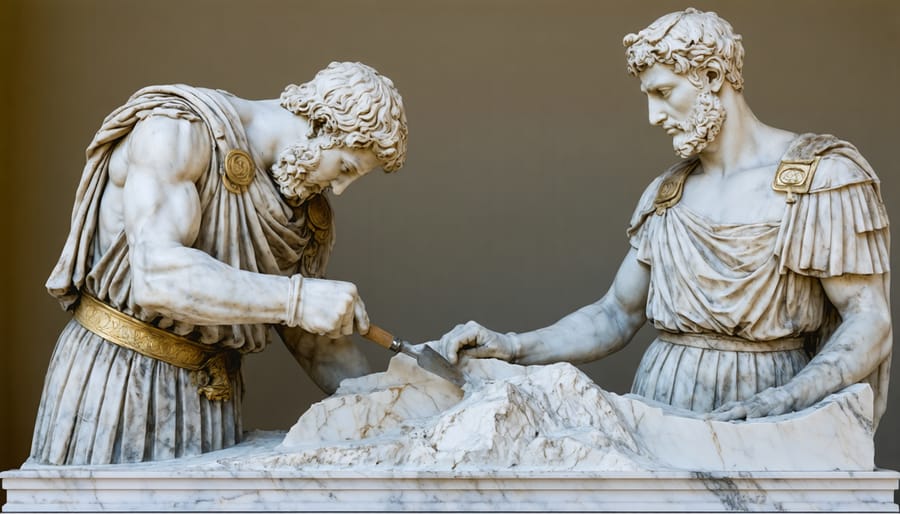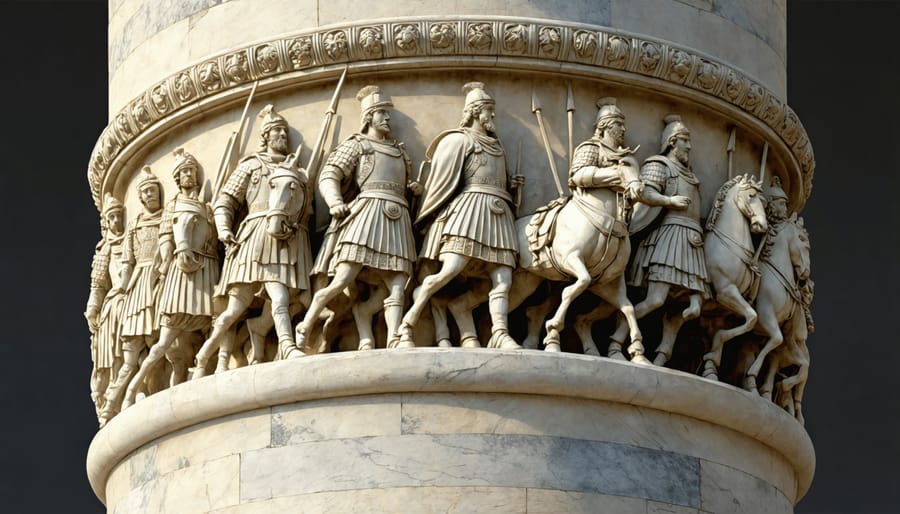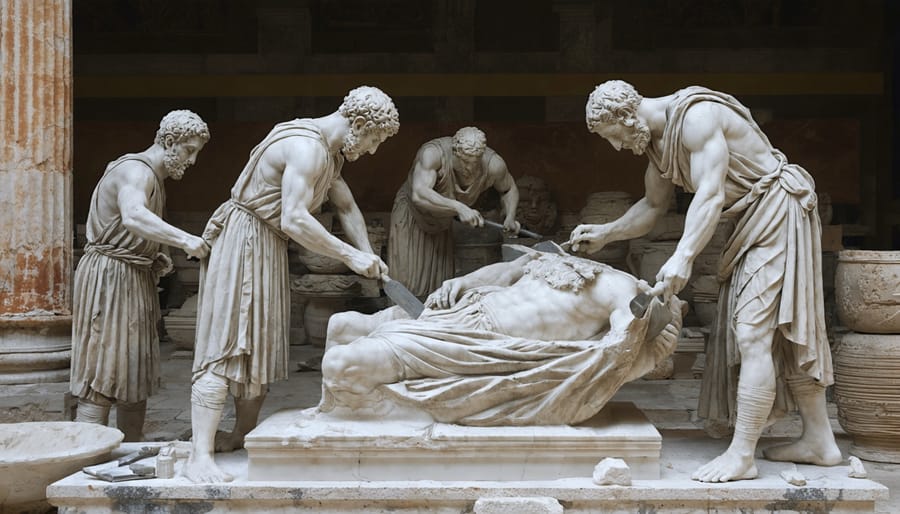The second century CE marked a transformative period in the journey of stone artistry, where Roman influence merged with local traditions across three continents. Masterful sculptors pushed technical boundaries, developing revolutionary techniques for carving marble and limestone that would influence artists for millennia. This era witnessed the emergence of distinctive portraiture styles, with imperial sculptures showcasing unprecedented realism in facial features and drapery details. From the sophisticated reliefs of Trajan’s Column to the delicate funerary portraits of Roman Egypt, second-century artisans established new standards for stone craftsmanship that continue to inspire modern sculptors and architects. Their innovative approaches to proportion, perspective, and surface treatment revolutionized how we understand and work with natural stone, creating a legacy that bridges ancient expertise with contemporary design principles.
The Golden Age of Roman Stone Sculpture
Technical Innovations in Stone Carving
The 2nd century marked significant advancements in stone carving techniques, particularly in the refinement of tools and the development of more sophisticated sculpting methods. Roman artisans introduced improved iron chisels with varying tip widths, allowing for greater precision in both rough cutting and detail work. These tools, when combined with newly developed abrasive materials like Naxian stone powder, enabled sculptors to achieve unprecedented levels of surface finish.
A notable innovation was the introduction of the running drill, which revolutionized the creation of deep folds in drapery and intricate hair textures. This mechanical tool allowed artists to create more naturalistic effects and deeper undercutting than previously possible. The period also saw the widespread adoption of pointing techniques, where measurements from a model were transferred to the stone block using a system of reference points, ensuring more accurate reproductions.
Craftsmen also refined their understanding of different stone types, particularly marble from newly discovered quarries. This knowledge led to more selective material usage based on the intended final effect. For example, fine-grained marbles were chosen for detailed facial features, while coarser varieties were preferred for architectural elements.
The period witnessed the development of specialized finishing techniques, including the use of rasps and files for creating varied surface textures. These innovations collectively contributed to the distinctive style of 2nd-century sculpture, characterized by its technical sophistication and naturalistic detail.
Preferred Stone Materials
During the 2nd century CE, Roman sculptors and artisans demonstrated a marked preference for specific stone materials, with marble reigning supreme among their choices. The finest white marble from Carrara and Pentelic quarries was particularly sought after for creating the era’s iconic marble monuments and sculptures. This material’s translucent quality and fine grain structure allowed artists to achieve remarkable detail and surface effects that captured the naturalistic style characteristic of the period.
Limestone, while less prestigious than marble, played a crucial role in regional artistic expression, especially in provincial areas of the Roman Empire. Its availability and durability made it a practical choice for architectural elements and relief sculptures. Artists also frequently employed travertine, particularly in central Italy, valued for its structural stability and warm, honey-colored tones.
Greek islands provided highly prized colored marbles, including the purple-veined Pavonazzetto and the yellow Giallo Antico from North Africa. These materials were often combined in sophisticated polychrome compositions, reflecting the period’s taste for luxury and visual complexity. The selection of stone materials during this era wasn’t merely practical but carried significant cultural and social implications, with certain types of marble becoming symbols of imperial power and artistic refinement.
Iconic Works and Their Impact
The Column of Marcus Aurelius
The Column of Marcus Aurelius stands as one of Rome’s most significant monumental sculptures, erected between 176 and 192 CE to commemorate the emperor’s military victories. Rising 100 feet high in Piazza Colonna, Rome, this masterpiece is carved from Carrara marble and features a continuous spiral relief that winds around the column 23 times, depicting scenes from the emperor’s campaigns against Germanic tribes and Sarmatians.
The column’s sculptural narrative showcases remarkable technical achievement in stone carving, with over 700 figures carved in deep relief. The scenes demonstrate sophisticated spatial composition and detailed storytelling, capturing both military operations and ceremonial events. Artists employed innovative techniques to create depth and perspective within the confined spiral format, setting new standards for Roman relief sculpture.
Notable features include the realistic portrayal of Roman soldiers and their adversaries, detailed military equipment, and atmospheric elements like rain and lightning represented through careful stone carving. The column’s preservation allows modern viewers to appreciate both the artistic excellence and historical documentation of second-century Roman military campaigns, while serving as an inspiration for contemporary stone sculptors and architectural designers.

Portrait Busts and Relief Sculptures
Portrait busts and relief sculptures emerged as dominant art forms during the 2nd century, reflecting both Roman cultural values and artistic innovation. These works typically depicted emperors, wealthy patrons, and distinguished citizens, carved with remarkable attention to realistic detail. Marble was the preferred medium, though some examples in bronze have survived.
Relief sculptures of this period demonstrated exceptional technical skill in depicting depth and perspective. The famous Marcus Aurelius Column, completed around 180 CE, showcases intricate narrative scenes spiraling upward, chronicling the emperor’s military campaigns. These reliefs exhibit sophisticated layering techniques, with figures arranged in multiple planes to create visual depth.
Portrait busts of the era marked a shift toward greater psychological realism, moving away from idealized representations. Artists captured individual characteristics, including age lines, facial expressions, and distinct features, while maintaining the dignity expected of official portraits. The treatment of hair and beard styles became particularly detailed, helping modern scholars date these works and understand contemporary fashion trends.
These sculptural forms significantly influenced subsequent artistic periods and continue to inspire contemporary stone carving techniques.
Legacy and Modern Influence
Contemporary Applications
The enduring influence of 2nd century stone artistry continues to inspire modern sculptors and architects. Contemporary artists frequently draw upon classical techniques for stone carving and finishing, particularly those developed during this pivotal period. The meticulous attention to surface treatment and the masterful understanding of how light interacts with stone surfaces remain relevant in today’s architectural and sculptural practices.
Modern stone workshops often employ modified versions of ancient tools and techniques, combining traditional craftsmanship with contemporary technology. The characteristic drilling and running technique developed in the 2nd century is still used to create intricate drapery effects in modern sculpture. Similarly, the graduated use of rasps and abrasives to achieve varying surface textures remains fundamental to stone finishing.
In architectural applications, the principles of 2nd century relief work inform contemporary facade designs. Many modern buildings incorporate classical elements interpreted through a contemporary lens, utilizing ancient techniques to create depth and visual interest in stone surfaces. The period’s understanding of proportion and scale continues to influence the way architects approach stone installation and decorative elements.
Conservation specialists also rely heavily on knowledge of 2nd century techniques when restoring historical monuments. By studying and replicating these ancient methods, they ensure authentic preservation while gaining insights that benefit modern stone craftsmanship.

The enduring legacy of 2nd century stone art continues to influence and inspire contemporary artists, architects, and designers. This transformative period marked significant developments in sculptural techniques, particularly in the manipulation of marble and other natural stones. The era’s masterful blend of realism and idealization set new standards for artistic expression that resonated through the centuries. From the detailed drapery of Roman portraits to the elegant architectural reliefs, these works demonstrate an unprecedented understanding of stone’s potential as an artistic medium. Modern stone practitioners still study these ancient techniques, finding valuable lessons in the precise carving methods and surface treatments developed during this period. The sophisticated handling of natural stone during the 2nd century remains a testament to human creativity and technical achievement, offering timeless inspiration for today’s architectural and sculptural applications.










